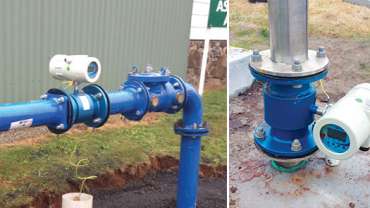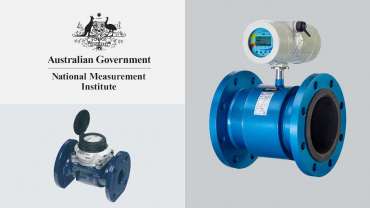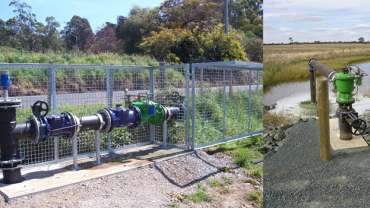Sizing And Installation Techniques For Electromagnetic Flow Meters.
Play PodcastIn episode nine of Controlling Water, we are looking at sizing and installation techniques in order to achieve good long term operation of electromagnetic flow meters, also known as mag flow meters. This week we’re joined by Colin Kirkland, one of Bermad’s Product Manager, to discuss the hydraulic requirements for the water flow and electrical needs when installing mag flow meters. Tune in to learn about the importance of understanding different environments, how to avoid these common mistakes, and how Bermad’s interactive training facilities empower teams like yours across Australia.
Transcript
| Sarah | Hello, and welcome to Controlling Water, a space for us to talk valves, water meters, and interesting insights about the water industry. Each episode we are joined in conversation by industry professionals that specialize in all things valves, meters and best practice knowledge in the water industry.
We’re here with Colin Kirkland, from Bermad Water Technologies, who is one of the product managers in the team. He has many years industry experience in working with water flow meters and more specifically electronics. In this episode of Controlling Water, we are discussing with Colin some of his suggestions in sizing and installation techniques in order to achieve good long term operation of electromagnetic flow meters, also known as mag flow meters. Welcome, Colin. |
| Colin | Thank you. |
| Sarah | All right. Let’s get started. So with installation advice, I understand that the installation of any electronic piece of equipment would be split into hydraulic requirements for the water flow and then electrical needs. Starting with the hydraulic side, what is a good starting point for a customer to consider? |
| Colin | Well, starting with a hydraulic side is a good thing, Sarah, because as a mechanical engineer, when I come to talk about the electronics, I know you mentioned the electronics in there. I know enough to be dangerous. |
| Sarah | Good to know. |
| Colin | But I’ll talk about what my limitations are, but there’ll be good information here on the installation, for sure. |
| Sarah | I love it. |
| Colin | Yeah. So it’s an interesting one, Sarah. We have been selling electromagnetic flow meters for many years now, and it’s become a very good part of our business. And one of the real aspects that we’ve found with supplying this product, like anything, is giving good information and really sizing correctly and giving good information to make sure the product works to its optimum. One of the things that we found over many years with a mag flow meter is people have generally said, look, why do I want a make flow meter? Well, I want something that’s accurate. I want something that’s simple. I’ve got a 200 millimeter pipe. I just want a 200 millimeter mag flow meter. And that’s what they put in.
Now, the reality is, a lot of people don’t generally size meters terribly well. When you’re thinking, what size meters should I use? They’ll say, well, that’s the size of the pipe. That’s what we’ve got. That’s what we’ll use. And it’s a really good starting point to have this conversation, because like anything, there’s an efficiency band where any product works at its best efficiency point, as in a pump or a valve or anything like that. And it’s the same for a mag flow meter. And if we simply take a 200 millimeter pipe and we put that 200 millimeter in, it could well be that we actually only need a 100 millimeter in there, because the flows are only up to 20 liters a second. Now it’s not to say that a large meter won’t operate at those low flows, but like everything else that we do, we like to make sure we’re giving clients or potential customers, really good information and choices to make sure we’re choosing the right product the first time and making it work well. So the best suggestion I would have, you know, a good starting point is starting with the hydraulics. What are the flow rates? What are the pressures that we’re looking to do? What’s the application? And let’s understand a bit about it. So it comes back to getting that good information. And the euromag meters that we have, they publish very good information in their manuals. The manuals are 72 pages long and I’m sure everyone reads every single page of those. |
| Sarah | Of course, page by page! |
| Colin | Page by page, you know, and page 68, they’ll tell you how to size the meter, but hopefully, listening to this podcast or looking at one of our YouTube clips or something, people will get a quick snapshot of what’s really important. And this is one of the starting points, which is very important. Get the flow rates right, we’ll size the meter for you and make sure it’s good and fit for purpose. That’s a starting point. |
| Sarah | Sounds good, sounds good. So I’d like to move on to the liquid that we’re passing through in relation to the meter design and whether it actually matters much about the liquid that is being passed through, and specifically I’m interested to know, can we use any grade of water for this type of product? |
| Colin | Yeah, well, water is typically what we are looking at. The mag flow meters are generally split into two different types of product. There is what we call a process meter, which might be pumping concrete or a slurry, or, like a liquid with a lot of solids or varying solids in it. And then we have ones that can basically pass water and associated minor slurries and solids and stuff too, as well. So we are specifically focusing on the standard type of meter and not the process meter here.
So the applications that we are typically seeing is we’re seeing things like irrigation water, drinking water, treated effluence, raw effluence, and some minor slurries or water qualities that include some solids, but there’s a distinct difference because you can have even instances where you are pumping… You might be at a beach and you’re pumping water and sand. You might be moving sand from one part of the beach to the other, and you pump it through this meter. So you’re talking about pumping something with highly variable consistency and the water’s very, very different in other words, and changing all the time. That’s not what we’re talking about. So yes, we are talking generally about water. That’s fairly consistent and is easily read through the mag flow itself. |
| Sarah | Right. And so, as long as that liquid is transmissible, |
| Colin | Yes. |
| Sarah | Is there any, are there any limitations on minimum and maximum flow where the meter will work best? |
| Colin | Well, the situation is, is that when I was saying in the start about sizing, the meter to suit the best principle or the best flow rate, as you’d say, is pretty important because if we have an oversized meter and the velocity is very low and let’s say, for example, we’re pumping irrigation water and the irrigation water can have a lot of colloidal clay in it. Now, if we were pumping in a very low flow rate and all of a sudden over time, what happens in the pipes is if it’s a low velocity, a lot of the solids will settle out in the product. We don’t want that.
So in a mag flow meter, we have a series of electrodes inside there, and we like the meter to be kept reasonably clean. And although the mag flow meter doesn’t care what the turbidity or the colour of the water is, it’s good to make sure that it’s efficient and it’s kept in good condition inside the pipe. Now you’re not gonna take the meter out and clean it every 10 minutes. That’s not gonna happen. But the key thing is, is that if you’ve sized the meter with the right velocity, for the specific flow, we know we can achieve a good result. So the thing is, is that typically the velocity profile we are looking for in any mag flow meter, we start with a velocity around about 0.05 of a meter per second, which is a very, very low velocity, but we can work right up to 10 meters per second. So that’s very unusual. A lot of pipe systems won’t be working at eight and 10 meters a second, but you can and then it will work and work well, and it’ll work within an accuracy level too, as well. The key thing is, is ensuring that it’s not too high a velocity that it creates turbulence. So again, we’ve got a lot of experience and a lot of good knowledge that we can share. If anyone’s in any doubt, they simply call us and we can share that advice with them because it is going to vary depending what the liquid is and what the application is. But yes, it’s important to know that. |
| Sarah | So valuable. So Colin, what sort of accuracy can someone expect compared to a mechanical water meter? Are they accurate? |
| Colin | Yes, they’re definitely accurate. And it’s one of the key reasons why someone will want to put one of those in. As an example, a typical mechanical water meter, if it’s operating within its nominal flow range, it’s design set of flow range would normally be plus or minus 2% up to a maximum plus or minus five. Now, if you are using any form of meter for billing, the more accurate it is, the better it’s gonna be. And that’s not good for the consumer, but it’s good for the person who’s putting the bill out.
A mag flow meter typically is gonna be accurate within 0.2 to 0.4 of a percent. So what that means is. Is that, what’s the difference between 0.2 and 0.4. Well, generally, if we have what we call a powered meter. In other words, if we use a constant 24 volt or 240 volt power supply, it’s gonna be accurate if we’re working within that correct velocity range of round about plus or minus 0.2 a percent. So that means it’s really good. The customer is going to know specifically they’re putting out a very accurate amount and they know that it’s really good information. The 0.4 generally is when we’re working with a battery powered unit. Because that has a slightly different, operating principle, a battery unit basically says, “Look, I’m going to wake up. I’m gonna look at a snapshot on the flow. And then after two seconds, I’ll go back to sleep. I’ll wake up 40 seconds later. I’ll look what the flow is and I’ll look where the flow last time was. I’ll average it, and then I’ll go back to sleep.” You know, so it constantly does that, because if we just use a battery and we constantly power it, it’ll just go dead. So it’s a slightly different principle where a constantly powered unit is constantly sampling many times a second, looking at the flow. It doesn’t care about power because it’s working there, but a battery unit, you want to extend that battery life as long as possible. |
| Sarah | Of course. |
| Colin | And so it’s not quite as accurate, but it’s still very accurate. What that means to a water company or a irrigation company or a user is that, imagine we’ve got the situation where we’re pumping water from a pumping station to 500 houses. We’re pumping at 100 liters a second. Now, if I go to all of the water users and look at their mechanical meters in their houses and look and see, does the amount of water flow I’m pumping out, match what I’m billing. Now in many cases, if it’s not, it’s gonna be questions asked. Well, are the meters out in the field not working well? Are there leaks? Is there water theft? There’s lots of things.
So being very accurate really means that it gives a lot of security to the people, putting the meter in that they’re getting very good, accurate information, as long as it’s installed correctly. |
| Sarah | Good to know. In relation to connecting to metal or plastic pipes. Is there anything specific to individual pipe materials that are important? |
| Colin | Yes. So most of the pipes that we’re talking about, where these are fitted can be stainless steel, they can be steel, ductile iron, and this are the metallic type pipes, or we could have polypipe or PVC, non metallic. And there’s usually a great variety of different pipes used in specific industries for very reasons. The important thing is that if you’re using metal pipe, that can conduct the electricity from the pipe through the microphone meter to the other side, whereas plastic pipe doesn’t. So there’s specific things that are very important and it’s talking about earthing of making sure that the product is properly earthed. Now this is where I’m talking electricity again. And I know you’re rolling your eyes here. |
| Sarah | Not at all. |
| Colin | No, no, but it’s one of the things we do in every mag flow meter at Sierra is we put what we call earthing rings,
On both sides of the meter. And what this does is ensures that we’re, if you have good earthing of the product, it means that we don’t use a lot of outside influence or interference that might affect the operation of the unit. So what we do, for example, when a meter rocks out of the box, you’ll see these two stainless steel rings on either side and they’ll be connected through wires, through to the sensor and the converter, and then to a certain earthing rod. Which means that we take away all of that noise and or electrical noise that can create variability in the meter. So really good earthing is exceptionally important to make sure we do it. So when I talk about plastic pipes, the question you asked was plastic or metal pipe. With metal pipes, it’s not quite as important to have good earthing, but with plastic pipes that can’t conduct that, we want very good earthing so, regardless of, because we don’t know a lot of the time, what we’re connecting to, we take the worst case situation. We provide good earthing rings, good earthing connections to all of the product to make sure that you’re gonna get the best performance out of the box. So, yes, it’s important. |
| Sarah | Good to know. All right. Another question for you, Colin. How important is the mating pipe to a meter? Do we really need so many straight upstream diameters both before and after? And what can we do if it is limited in the number of diameters? |
| Colin | Yes. A lot of mechanical, or electromagnetic flow meters for many years that require a nice, smooth, laminar flow of the water coming into the meter and leaving it. Why? Because if the water’s highly turbulent and it’s come up through bins and it’s going through valves and it’s very agitated, that means we’re not gonna get good performance or accurate performance. Now I told you how accurate the meters were. But I did say at the end that was subject to good installation techniques, you know? So that’s why your question is really relevant. When we’re meeting to whatever material of pipe we wanna try and keep the inside diameter of the pipe within about 5% of the diameter of the mag flow.
So for example, it was a 200 millimeter meter. We want us try and stay within 200 millimeters, both sides. Now why that makes a difference. Imagine you’ve got a plastic pipe before it, and it attaches up to the meter, but it’s got a very small inside diameter. So let’s say instead of being 200 millimeters, it’s 170 millimeters. That means the water’s gonna come through with a jetting action and it’s gonna change the velocity profile in the meter. What all that means is, inaccurate. So they’re exceptionally accurate these products, but it’s important that we have non-turbulent flow. Now we have meters. For example, we have the model 2200 Euromag meter. Generally it’s designed to use about five straight diameters before and three diameters afterwards and that makes it work exceptionally well, exceptionally accurate. It smooths the water out. Works really well. We have the model MUT2300 which requires zero and zero diameters. So we can actually use no straight diameters and it’ll still work exceptionally well, regardless of that, we still want as best we can and if you’re going to put a product in where you’re billing and you’re wanting accuracy, it’s best that you really consider getting the pipe mated to it correctly, get the straight diameters correctly and make sure that it’s going to work to its optimum. Because the reason why I’m saying this is that when we’ve experienced someone’s put a meter in and it hasn’t worked terribly well, and they’ve said, you know, Colin, I trust in you this was gonna work well, but we’re experiencing this. Then we go back to the installation and back to that 72 page manual that everyone reads from front to back. |
| Sarah | Yes. |
| Colin | They never read it. |
| Sarah | They never do. |
| Colin | They never read it. So it’s about learning from mistakes and trying to talk about some of those things. The 2200 meter that I was explaining before requires five and three diameters. Now, we’ve actually got it approved for three and zero diameters as well, in certain applications. But as long as the floor is modest and it’s within a flow profile that’s been suggested for and tested and everything else. So it’s not as simple as it sounds. This always seems like a very simple product. 200mm pipe. 200 millimeter in, just plunk it and it’ll work. What can go wrong? Lots.
So really important that you speak to Bermad. Speak to the Euromag product manager, if need be, or one of the specialists that can really ask the right questions to make sure we get it right the first time. A really good example of this is, in a lot cities, when we have runoff water that goes to the sewer. Sometimes we want to actually measure what that runoff is going to the sewer so that we know that we’ve got X amount of water coming into a building. We’ve got X going out and we know what’s going on. Now a lot of the time, if the liquid coming out of the pipe is coming out at such a low velocity, the meter might not even read it. Because they put a hundred milimeter pipe in and it’s flowing away nicely, but they only need a 25 millimeter. So it all comes back to due diligence. Making sure the meters fit for purpose in the application that it’s being used for and making sure we connect the right pipe, do the right earthing and get the whole package correct when we’re doing it. |
| Sarah | Very interesting, Colin. Let’s take a short break. If you have any questions that you would like answered during this podcast, feel free to get in touch with us through our website, Bermad.com.au or send us an email info.au@bermad.com and Colin will be sure to answer them. Now, back to the show.
So we’ve also in many instances discussed the use of air release valves in pipes. Are these needed with mag flow meters specifically? And does it matter if the pipe is full of water all the time? |
| Colin | Critical. You know, I love air release valves. |
| Sarah | I do, I do. |
| Colin | But on a really important point and this isn’t based on just the Euromag meter, this is in general principle. The meter is always assuming that it’s filled full of water.
And now there are certain devices that we even put on the meter we call an empty pipe electrode that basically says, look, if you do have a presence of air in the unit, I’m gonna give you an alarm. Because, the reason for this is that because air is compressible, if we have an air pocket stuck in the meter and the pump is pumping water through the meter, it could be that the air pocket is compressing and releasing, and compressing and releasing, and the meter is oscillating up and down, and it’s not working well. So there’s a lot of very good knowledge, which we’ve got in how to ensure that we don’t have air in the meter itself. Now, one of them may be putting an air release valve before it, to ensure that we release any of that entrained air and there’s methodology in how we want to install it and do that. But it’s exceptionally important. We may decide that, look, we don’t wanna put the meter in the horizontal, because the velocities are very low and that air pocket might get stuck there. So we might want to put a slight incline on the pipe so that the air is rising through the meter, and it’s going to a highpoint, so it’s not working. So it’s working properly. We may even put the meter going vertically, straight up, so all the air has to go through the meter. It makes it work a lot more efficiently. So, there’s a lot of experience that we have in ensuring that when you install the meter, we get the optimum performance, because we spoke earlier of that accuracy of plus or minus 0.2%. That all goes out the window if you’ve got air in there, you know, the thing could oscillate up and down, and if you are billing someone for incorrect meeting, that’s not good. So utilize the experience that we’ve got hydraulically. The big benefit of Bermad is that we really understand hydraulics, and we’ve got industry experts that understand the electronics of it too, as well. And that’s not me, but they really understand that well, and the amalgamation of the two, make sure that we get the products that work well. So, really getting that combination of the installation right is critical, and air valves may be part of the solution, or changing the pipe inclination, or getting that design, again if you’re in doubt, that’s a question that just needs to be asked on a simple phone call, and avoids those issues because the reason why I’m mentioning a lot of this is that if I were to list all of the issues that we’ve had with particular valves, meters, or whatever, you learn from mistakes. And this is all about learning from mistakes and making sure we get it right before we even, you know, with the first time it goes in. |
| Sarah | Absolutely. So let’s talk a little bit about fitting meters, for a moment. Is there anything unique about fitting meters next to pumps considering that both electric driven and more so diesel driven pumps can have quite a high degree of pipe vibration? |
| Colin | Yeah, absolutely. Generally when we come out of centrifugal pumps, it’s very common to put a micrometer very close to it. But usually, the discharge manifold coming off a pump usually is quite small and it expands to a larger pipe size.
But it’s highly turbulent. You know, this water’s come into the center of an impeller. It’s been spun around at 3000 RPM. It’s gone through check valves. You’ve basically agitated the water beyond belief, and then you’re putting it through a mag flow and wondering why it’s not stable, you know? |
| Sarah | Yes. |
| Colin | So, yes you can put mag flows and pump stations, but we want to get to a location where it’s as stable as possible. You mentioned diesel and electric pumps, well, when a diesel is running and driving a pump, it’s got a lot of harmonics.
And there’s a lot of noise and vibration and everything else too, as well. If you were to take your phone, and put it on a pipe sitting next to a diesel pump. It would vibrate off in two seconds and I’m sure the electronics in there wouldn’t like it either. So, one of the things that’s really critical when you’re coming to install a mag flow meter is that we have two general principles of installation. One is that we have the flow tube or the sensor and we hard attach the sensor to it. So it’s what we call close coupled. Now, if that’s all close coupled, and we’ve got a diesel vibrating like mad, the vibration in there is not good for the electronics and it’s basically going to, it can make the unit not work well, and it can affect all of the intricacies in there that’s going to fail. So one of the things we can do is that we can put vibration eliminators on the pipe and everything else, but easier than that, we can separate the electronics. Or the sensor from the converter and we run some separate wire. We put the device, that’s reading the flow, separate away from all the vibration and that’s great. So it’s a very good question to have when we’re starting the conversation. Do you wanna mag flow? Are you putting it near a pump? Is there any pipeline harmonics you’re thinking about here that we might want to separate this away? So it costs more, but it’s a question to be asked at the start. It’s something to avoid that going wrong. So, it’s not to say that the meters are not gonna work in a pump station. Of course it will. They have, and have for many years. But again, if you want that accuracy, stability and long term performance, ask the questions and we might decide to remote minded. Might be slightly more expensive, but so be it. |
| Sarah | So be it. So Colin, this brings us to the separate electrical side of the installation with the converter. |
| Colin | Yes. |
| Sarah | I understand you have a multitude of different models, that accept battery. |
| Colin | Yes. |
| Sarah | Low voltage and high voltage supply to operate the meter. |
| Colin | Sure. |
| Sarah | Are there specific details needed to ensure good operation of the meter? |
| Colin | Absolutely. So like any piece of electrical equipment we want to put in sort of protection to ensure that we don’t get surges. So for example, when we put our TV in at home, we might put surge protectors in you know, to stop if we have a lightning strike.
Breaking the TV, et cetera. Same thing goes for any electrical instrument. So, because I know nothing about those at all, I’m going to leave it at that. But on a serious note, it is an electrical piece of equipment that should be installed by an electrical contractor. |
| Sarah | Absolutely. |
| Colin | Now a lot of the time you may find that you’ve got a plumbing contractor with due respect to plumbers or, you know, civil contractors they’re putting in a piece of electronics, but it should be done by a proper electrician, and certified, because obviously A; we’re talking about voltage, so it’s dangerous and we wanna make sure you get the best performance and it’s safe. That’s number one. So the first thing is, I guess, is that having a proper electrician or accredited person putting it in is critical.
Generally, there’s three different levels of what we call constant power voltage. One of them is we call high voltage, that’s 240 volt. Similar to what we’re plugging into you know, when we put our TV, et cetera in, and then we have low voltage. So that might be 12 to 24 volt AC or DC, which is a much safer voltage to work with, has exactly the same sort of performance, but there’s obviously it needs to be correct within a voltage range, et cetera, too, as well. Then we have solar, so the solar basically we may be out in the country, we’ve got some solar panels. We’re gonna take 13 volts from there. We’re gonna put it into a battery and the battery is going to drive it as well. So they’re the three voltages that we’ve got and it’s an option that has to be decided at the time of order. Which one best suits the application, or we have battery. Now the thing to understand about, I did mention it briefly in the start, a constantly powered unit is always the best product for performance. Why? Because it’s sampling many times a second. It’s giving us great performance. It’s working really well. And we know it’s gonna be highly accurate. The battery powered unit, conversely, if it’s just purely a battery on its own, what we want to try and do with a battery powered unit is ensure that the battery gives us the longest life possible. So, as I explained before, the battery system basically says, I’m gonna wake up, take a snapshot of the flow, go back to sleep. Wake up X amount of seconds later, and we can adjust the period between the time that it wakes up. It wakes up again, looks at the snapshot, goes back to sleep. So it’s averaging the flows. |
| Sarah | Sure. |
| Colin | Now, if we want to get a lot more accuracy in a battery unit, we can make the dwell time between the two shorter. There’s things that we can do to make it work better, but it’s gonna drain the battery down.
So it’s a balance between. Do I want five years or 10 years life? Or one year life? Or, I don’t have power. Maybe I can use solar, et cetera, but a powered unit is always gonna be more accurate and it is gonna be a better option in my opinion. Battery’s great. If we’re in a remote location and we just wanna know what’s going on, that’s fine. Now we can actually have a combination of both as well. So we can actually even have a powered unit that works really well and works. It’s fine. But what if the power fails? So if the power were to fail, the meter’s not operating, the diesel pump still runs pumping water through, and there’s no catching of the water. We can put a battery back up in to say, well, even if the power fails, we can have that option too as well. So it’s a very good question to have to someone who understands electrics. To really speak about, you know, and make sure that we get the right voltage or power supply to suit the best performance that we need for the application. It’s good having all of those options to make sure we get the best result possibly. |
| Sarah | Absolutely. It’s often spoken when working with electronics altogether about proper earthing of the product. Is this generally required for both metal and plastic pipes? And how critical is it for the meters to work well? |
| Colin | Yeah, look, we briefed on that earlier. It is critical. Yeah. Look, it is critical. The bottom line is, and I’ve been taught this from good industry people who understand a lot more than I do, that good earthing is always the best thing to have. So what we are really thinking about here is that we could have situations where if we’ve got a separate unit mounted here, so say we were at a diesel pump and we’ve got the converter remote mounted from the sensor, and we’ve got the cable in a cable tray where we’ve got high power or we’ve got other sort of electrics in that reasonable amount of pressure sensors and everything else. We can get electrical interference. Electrical interference can really affect how the performance work. Having good earthing really makes sure that we really maximize the performance of the product best. Regardless if it’s plastic pipe that we spoke before or metal pipe, if we do this, we get the best result possible. And that’s what we always want. You know, a lot of the time I’ve seen many meters out there installed where are the earthing is just not connected? And we figure, it’ll be right. Don’t worry. And, and it may well be right. |
| Sarah | Yeah. |
| Colin | But the key thing is that, even when you’re doing earthing, making sure that that earth is connected to its own independent stake. So for example, we might have in a pumping station, pressure sensors, we might have little dosing pumps or a variety of electrical instruments that all need earthing and what the electrician might do is they’ll run one big earth bar. We’ll put all of those earths in together and we’ll run it to one station.
That’s not so good sometimes because we can get contamination of noise and electrical issues, which can affect the performance of the unit. So for best practice, I’ve always been taught using independent earth for that product to give the best performance. It’s not to say it’s not gonna work if we put it on that earth bar, but just thinking, you know, if you want the best performance, do it best costs a little bit more, but we get the right result. And even things like, well, when we earth the product, we put an earthing stake in the ground. It matters what the earth looks like. You know, if it’s clay, soil, or Sandy, we might have to use that gas steak right down. So we get proper earthing of it, you know. So again, this is something that you can speak to our instrument technicians or product managers to get very good, detailed information, or an electrician knows this as well, too, as well. But again, if you’re in any doubt, that’s a phone call, quick phone call to make sure it’s gonna be right from the start. |
| Sarah | Absolutely worth it, Colin. This has been extremely useful, and it’s obvious that, you know, a lot of this off the top of your head. Which is fantastic. |
| Colin | No, no, no. Some of it not all of it. Some of it, yes. |
| Sarah | So where can people get these tools and requirements? And do you have any support videos or other tools that might assist people? |
| Colin | Definitely with every product which we supply, we supply a memory stick with every meter that we got, which has got the full manual in there. We provide a hard copy of the manual. All jokes aside, no one reads it or they only read it when something’s going wrong or they’re trying to find something else.
And the reality today is things like YouTube. You know, we have Damien Muir, our product specialist, who does some wonderful videos on there that you can watch snapshots of earthing, how to run the analog outputs, how to check mod bus, how to do a variety of different technical things very quickly and easily without watching a 40 minute video, we can snapshot in there. So, we like to do those things and go to all those points and put out instructional videos and YouTube clips and stuff, which is on our website at www.bermad.com.au. We have them on our own YouTube channel too, as well. So we find they’re really useful when you go to our site, you can get the exact manuals that suit, because I think one of the frustrations with a product like this here is that when you’ve got a product that might be installed by a plumber or civil contractor, but it’s not an electrician. It’s a job for two technicians here, basically. And to find the right information with all jobs aside, we need 72 pages in that manual because it’s important. But the key thing is that if you can go straight to a very simple clip that shows you exactly what we need – Great. But like everything that we do, we like to empower our customers, get them to our facility, train them. So if this is something that you’re doing, and you’re constantly working with some of these, maybe come to one of our interactive training facilities, you can see the product, you can modify the set points, change the units, do all of the things that you may want to do to make this interface with whatever telemetry unit or whatever it’s gonna be working with to make it work well. So, we really encourage people to go to our site or come to us for training to make it work well. Cause at the end of the day we wanna do it once, we wanna do it the first time. |
| Sarah | Indeed. |
| Colin | Get it successful. |
| Sarah | Thank you so much for your time today, Colin, it’s been a wonderful chat as always. |
| Colin | That’s great. Thank you for that. |
| Sarah | For more learnings about the water industry, including products, tips, installations, operation, and maintenance techniques, head over to www.bermad.com.au and subscribe to our industry newsletter. You’ll join more than 3,000 industry professionals and learn from the experienced Bermad team of industry specialists. Thanks for tuning in to this episode of controlling water. For more episodes, resources, and how-to’s, head to www.bermad.com.au |
-
Colin has more than 40 years’ experience working in water supply and irrigation in Australia, including 24 years with BWT. He credits his training at Weir pumps in his native Scotland for providing him with a solid grounding in engineering.
Colin is a mechanical engineer and a fitter and turner, who prides himself on taking a hands-on approach when designing and implementing successful installations across all aspects of BWT’s products and markets.
Read more about Colin: Who’s who at BWT – Colin Kirkland
Want more details?
To get more information about the training topics we offer, get in contact with our experts.












